
The Vickers VC.1 Viking is a British twin-engine short-range airliner derived from the Vickers Wellington bomber and built by Vickers-Armstrongs Limited at Brooklands near Weybridge in Surrey. After the Second World War, the Viking was an important airliner with British airlines, pending the development of turboprop aircraft like the Viscount. An experimental airframe was fitted with Rolls-Royce Nene turbojets and first flown in 1948 as the world's first pure jet transport aircraft. Military developments were the Vickers Valetta and the Vickers Varsity.

The Fiat G.55 Centauro was a single-engine single-seat World War II fighter aircraft used by the Regia Aeronautica and the Aeronautica Nazionale Repubblicana in 1943–1945. It was designed and built in Turin by Fiat. The Fiat G.55 was arguably the best type produced in Italy during World War II, but it did not enter production until 1943, when, after comparative tests against the Messerschmitt Bf 109G and the Focke-Wulf Fw 190, the Luftwaffe itself regarded the Fiat G.55 as "the best Axis fighter".

The Fokker S-11 Instructor is a single-engine two-seater propeller aircraft designed and manufactured by the Dutch aircraft manufacturer Fokker. It first flew in December 1947 and went on production, serving in several Air Forces in the late 20th century, including with Dutch, Italian, Israeli, Paraguay, Bolivian and Brazilian armed forces. The S-12 was a tricycle landing version of this aircraft.

The Agusta CP-110, also known as CVV P.110 or Politecnico P.110, was a prototype Italian four-seat light aircraft first flown in 1951 that failed to attract interest from either civil or military operators, although it was evaluated by the Aeronautica Militare. Originally designed and built by the CVV -, production aircraft were to have been built by Agusta, but for lack of interest.

The Alfa Romeo 115 is an Italian six-cylinder air-cooled inverted inline engine for aircraft use, mainly for training and light planes, based on the de Havilland Gipsy Six engine. Production totalled approximately 1,600 units. Derivatives of the 115 include the -1, bis, ter and Alfa Romeo 116.

The Ambrosini S.1001 Grifo ("Griffin") was an Italian light airplane that appeared shortly after the end of World War II. The first plane built by SAI Ambrosini postwar, the prototype flew in 1947 and was derived from the pre-war SAI.2S. It was a four-seat monoplane with spatted fixed undercarriage. A small series was produced for the Italian aeroclubs with an Alfa Romeo 110-ter engine of 97 kW (130 hp). Three examples were even bought by the Italian Aeronautica Militare (AMI), which used them between 1948 and 1950.

The Breda Ba.25 was an Italian two-seat biplane trainer designed and built by the Breda company. It was the most widely used Italian basic trainer of the 1930s.

The Caproni Bergamaschi AP.1 was an Italian monoplane attack aircraft designed by Cesare Pallavicino, coming from the Breda firm.

The Caproni Vizzola F.5 was an Italian fighter aircraft that was built by Caproni. It was a single-seat, low-wing cantilever monoplane with retractable landing gear.

The Fiat G.12 was an Italian transport aircraft of World War II.

The Caproni Ca.97 was a civil utility aircraft produced in Italy in the late 1920s and early 1930s. As originally designed, it was a high-wing braced trimotor monoplane of conventional configuration with one engine mounted on the nose and the other two carried on strut-mounted nacelles at the fuselage sides. Examples were also produced with only the nose engine or only the two nacelle-mounted engines.

The Fiat G.212 was an Italian three-engine airliner of the 1940s. An enlarged development of Fiat's earlier G.12 transport, it was used in small numbers in commercial service and by the Italian Air Force.

The Nardi FN.305 was an Italian fighter trainer and liaison monoplane developed by the Fratelli Nardi company.

The Fiat G.80 was a military jet trainer designed and produced by the Italian aircraft manufacturer Fiat. It has the distinction of being the first true jet-powered indigenous aircraft to be flown by Italy.

The SAIMAN 200 was a 1930s Italian two-seat primary trainer designed and built by the Società Industrie Meccaniche Aeronautiche Navali (SAIMAN).

The SAIMAN 202 was a 1930s Italian two-seat cabin monoplane designed and built by the Società Industrie Meccaniche Aeronautiche Navali (SAIMAN).

The Macchi MB.308, later Aermacchi MB-308, was a light aircraft produced in Italy in the late 1940s.

The Macchi MB.323 was an Italian single-engine basic training monoplane designed and built by Macchi. No orders were placed and only a prototype was built.

The FiatG.91Y is an Italian ground-attack and reconnaissance aircraft which first flew in 1966. Although resembling its predecessor, the Fiat G.91, the aircraft was in fact a complete redesign, a major difference being that it was equipped with a new twin-engine configuration, replacing the original single engine.
The Alfa Romeo Avio was an Italian aviation company producing aircraft engines active since 1941. It was founded as a division of Alfa Romeo but was sold to Aeritalia in 1986 and then to Fiat in 1996. It was merged with Fiat Avio in 2003 as Avio S.p.A.























